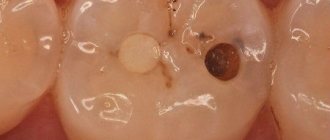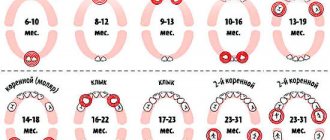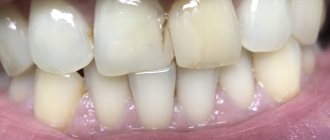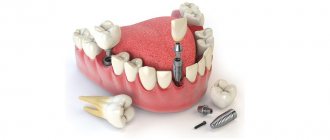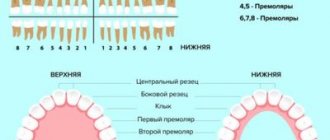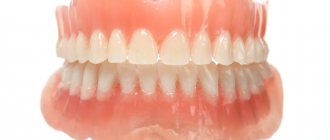Publication date: 03/30/2021
The absence of incisors affects the aesthetics, speech, diction and self-confidence of any person.
Incisors are teeth in the frontal zone. These include four upper and four lower elements. The two central ones are called units, the ones next to the canines are called twos or lateral teeth. They have one root and a cutting flat crown. They perform the function of cutting and biting food. And, of course, they decorate us when we smile and laugh.
In modern dentistry there are several methods to eliminate this problem, restoring a beautiful smile, healthy teeth and good mood.
Absence of incisors and effective techniques for correcting the situation
The absence of incisors and any other teeth in dentistry is called adentia. Congenital and acquired adentia are noted. Partial is common, but complete congenital is extremely rare. Losing all teeth is more often the fate of older people, when the functioning of the immune system and the body as a whole slows down, and a gradual loss of a large number of elements occurs.
The upper incisors are more often absent than the lower ones; the reason for this is still unknown.
If there are no incisors, this does not mean that you can leave it like that; it is better to contact a professional dentist in the clinic and correct the defect. Regardless of whether it is congenital or due to injury, unsuccessful treatment, or even an advanced disease.
There are effective techniques that can offer a solution to the problem of missing incisors:
- Orthopedic. An orthopedic dentist will offer prosthetics - crowns, bridges, microprostheses, implants;
- Orthodontic. The orthodontist determines the type of structures and braces that will help move the existing teeth to the place of the missing ones.
Each of the proposed treatment methods will help make the absence of jaw incisors invisible or replace them with artificial analogues. In no way inferior to natural teeth.
Is it possible not to treat edentulous incisors - the main dangers
The incisors enter the smile zone, so their absence becomes noticeable to others. Often the patient hears uncomfortable questions, such as “what’s wrong with your teeth?” As a result, the person becomes withdrawn and tries not to speak or smile in public, because... self-esteem decreases. In addition to psycho-emotional disorders, physiological problems appear - the gums are injured when biting off rough food, pieces of food get stuck in the wide interdental spaces. Food plaque becomes a breeding ground for dangerous microorganisms. As a result, cervical caries appears on the canines and premolars, gingivitis occurs and its complication is periodontitis.
Due to improper chewing, muscle tone decreases and problems arise with the temporomandibular joint (clicking is heard when opening/closing the mouth, jaw movement becomes difficult). As you can see, there are quite a lot of problems. Therefore, you should not delay treatment - you should definitely consult a dentist.
What dangers await patients with missing incisors?
Edentia of any tooth is an imbalance in the entire dental system, including the absence of lateral, upper, and lower incisors, regardless of location. The problem cannot be put off for long. Otherwise, you may encounter negative consequences such as:
- increased load on other teeth, which leads to rapid wear of the enamel, the possibility of cracks, and bone tissue atrophy;
- traumatic occlusion, when when closing the jaws, the periodontal tissues are overloaded, which even causes loosening of the teeth and their mobility;
- displacement of teeth due to the fact that there is no incisor on the opposite jaw; the tooth that has lost support begins to shift, just like the neighboring ones. The bite changes and joint changes in the jaw occur;
- functional disorders. The absence of incisors contributes to improper biting of food, swallowing, speech impediment, splashing of saliva during a conversation;
- Bone tissue atrophy due to insufficient load begins to develop 3-6 months after the removal of the incisors. Volume loss becomes an indication for bone grafting during planned implantation;
- change in a person’s appearance: in the absence of upper incisors, the soft tissues of the lip recede, the proportions of the face change with greater edentia, and if there are no lateral teeth, large gaps and cracks appear between the elements of the frontal row.
Diagnostics
The upper jaw is more susceptible to various anomalies, so the absence of upper incisors is more common. The main sign of edentia is free space on the jaw arch, where the tooth should normally be. Units may remain rudimentary or absent altogether.
The doctor makes the diagnosis based on the results of a visual examination and x-ray examination (orthopantomogram). In a panoramic photograph of both jaws, the rudiments of teeth (if any), the degree of their development, and the structural features of the jaw bone are clearly visible.
Reasons for absence
In practice, there are clinical cases where the front teeth are missing from birth - this is called the primary absence of incisors. More often in a child these are doubles of the upper jaw, usually in pairs - on both sides. If only one incisor is missing, then the second is most likely small and underdeveloped. If it is not detected during a simple examination, it can be seen in the jaw bone on an x-ray.
At 6-7 years old, the child begins to change incisors; if new teeth have not appeared, edentia occurs.
Why are the incisors missing:
- heredity;
- a violation of intrauterine development, when during the formation of the germ of teeth in the embryo, something went wrong: the woman’s illness, taking serious medications;
- serious childhood diseases, including genetic ones;
- endocrine disorders, hormonal imbalances;
- untreated baby teeth;
- taking medications;
- lack of vitamins, minerals, metabolic disorders.
Secondary absence of incisors occurs in adults in case of injury, untimely treatment of caries, pulpitis, cysts and other diseases (including gums) that destroy the tooth. When the doctor is forced to remove an incisor. Another reason may be unprofessional treatment and poor-quality implantation.
Why might a defect occur?
The absence of teeth is called “edentia”. It comes in the following types:
- primary: teeth did not erupt at all,
- secondary: the incisors were lost some time after eruption,
- partial: missing 1 or several teeth,
- complete: all teeth are missing.
As for the absence of incisors, both primary and secondary partial adentia can be observed here. Secondary occurs as a result of progressive caries, periodontitis or trauma (blows, bruises). Primary adentia may appear for the following reasons:
- heredity: cases of genetic transmission of anomalies of the dental system from generation to generation are quite common,
- congenital developmental pathologies: diseases of a woman during pregnancy, disruptions in intrauterine development can provoke adentia in the primary occlusion,
- developmental pathologies after birth: as for permanent dentition, primary adentia here can appear due to serious health problems in early childhood or due to diseases of the milk “ones” and “twos” (the first and second incisors, respectively). It has been proven that the developing rudiments of permanent teeth can be damaged due to caries, pulpitis or periodontitis in a child, as well as due to poor nutrition or lack of calcium and vitamin D
Read on the topic: what is adentia and how to treat it.
Symptoms and manifestations of edentia
The main symptom of edentulous incisors is their absence in the dentition.
At the same time, they can have an impacted form - be in the bone or gum. This can only be seen on x-ray diagnostics.
Most often, people turn to the dentist in the absence of lateral incisors - twos. Due to the resulting empty space, neighboring elements, fangs, are displaced. Such defects appear as cracks (cracks), malocclusion, deterioration of speech (lisp, whistling during a conversation).
And there are unique cases when a person does not even know that he is missing some teeth, believing that everything is normal. Only on an X-ray image does he see his missing incisors in the bone tissue, which were never born.
Clinical picture
Congenital absence of lateral (lateral) incisors is in first place among other edentulous diseases in terms of frequency of distribution. Their rudiments are absent in every 100th person.
Reference. The eight frontal teeth are called incisors (dentes incisivi) – 4 above, 4 below. They are intended for separating (cutting) food.
The incisors are designated according to the international classification by the numbers 11, 12, 21, 22 (upper) and 31, 32, 41, 42 (lower). The teeth that are located on the edge of the incisal row (12, 22, 32, 42) are called lateral or “twos”.
Those that stand in the center (11, 21, 31, 41) are medial or (“units”). The lower incisors are slightly smaller than the upper ones. The trend is that the congenital absence of “ones” and “twos” is becoming more common.
In addition to the reduced number of frontal teeth, true edentulism of the incisors is manifested by a diastema (gap) between the front teeth. The canines adjacent to the missing elements shift towards them during development, as a result of which the width of the diastema is insufficient for installation of a prosthesis.
The absence of 2 lateral incisors is more common. If only one grows, then it is usually smaller in size, that is, it is a microdent.
Edentia of the incisors is usually diagnosed in childhood, when permanent teeth begin to emerge. This happens in the sixth or seventh year. If eruption does not occur, this indicates edentia. But without radiography it is impossible to say for sure whether primary adentia or retention occurs.
Treatment methods
Orthodontic treatment method
The absence of incisors is dealt with by an orthodontist. There are several options for installing structures - braces, springs, rods:
- shifting the canine to the center, in place of the missing incisor. After its location there, the canine is shaped and adjusted to fit the lateral incisor. However, over time, a straight bite can form, which is a violation, leading to rapid abrasion of the enamel and disruption of the jaw joint;
- shift of the canine in the distal direction. By retracting the canine tooth toward the premolars, space is created for further implantation or prosthesis placement to fill the empty space.
Prosthetics.
After removing the incisors or creating enough space for prosthetics using orthodontic structures, the doctor chooses a method for restoring an artificial tooth.
Adhesive prosthesis
often used for anterior teeth. It is fixed to the adjacent teeth, in which special notches are made for its installation. The prosthesis is aesthetic, can withstand loads, but for its use it is necessary to exclude the presence of such factors as:
- bruxism
- mobility of supporting teeth
- severe decay of these teeth
- allergy to dental material
Filling material and veneers (Lumineers)
suitable in the absence of lateral incisors, when three gaps appear between the canine and the unit. The doctor can use a filling composite, placing it on adjacent teeth, building up and filling the space. Or use microprostheses - veneers, thin overlays that are glued onto the previously ground down surface of the tooth. Veneers and lumineers return aesthetics to the front row.
Veneers can also correct the shape of fangs after the orthodontist’s work, shifting them towards the incisors, turning them into snow-white “twos”.
Implantation
- one of the types of solution to the problem of the absence of lateral or anterior incisors. Once the site for the implantation of an artificial tooth root - an implant - has been prepared, a bed is made in the bone and gum, and installation takes place. After complete healing, the abutment and artificial crown are fixed.
The most reliable way to restore a missing incisor, but it has a number of contraindications, one of which is children under 18 years of age, while the bone is growing.
Orthopedic methods (tooth replacement)
Prosthetics is possible in two ways - removable and fixed dentures. As for removable dentures (immediate dentures, clasp dentures, acrylic ones), they can only be considered as a temporary solution, since their fastening is very unreliable and the aesthetics are low. Therefore, fixed prosthetics in the absence of incisors is a priority in treatment. Let us further dwell on commonly used options for the restoration of defects.
Artistic extension
If the gaps on the sides of the fang are not very pronounced, or the dental crowns themselves are quite wide, then the method of artistic restoration with a filling is used. Using a special composite material that exactly replicates the natural color and translucency of the enamel, the crowns are increased in width. The extension is quite aesthetic and can be used on children (if the child is able to sit in a chair for a long time, because the work is not fast). The downside is the low service life and the material’s susceptibility to chipping.
Veneers and Lumineers
Microprostheses – veneers, lumineers – are an excellent option to close gaps and recreate the aesthetics of a smile. The principle of operation is as follows: thin ceramic linings are attached to the frontal incisors and canines. They should be slightly wider than the crowns themselves (to “hide” the defect). Veneers and lumineers are installed in patients over 18 years of age. Ceramic veneers last more than 7 years, and zirconium onlays last from 20 years. The solution is considered quite modern, but patients should remember that biting food with the front teeth is prohibited due to the risk of chipping - you will have to first cut the food into small pieces. As for installing veneers, the “native” enamel of the front teeth will have to be ground down a little. Treatment is considered quite expensive.
Bridges
Bridges (or “bridges” as patients call them) are several crowns joined together, with the outermost crowns being placed on abutments. Bridges are considered a traditional method of restoration and will actually wear comfortably for a while. But do not forget that the supporting elements are often first depulped (the nerve is removed) and must be ground down. That is, if the tightness of the connection is broken, bacteria penetrate into the abutment tooth. As a result, after a few years, the supports may collapse from secondary caries, and the patient will lose all the teeth in the “smile zone.”
Adhesive prostheses
An adhesive prosthesis is also essentially a bridge and looks like a crown with “wings” on the sides - these elements serve as attachments to adjacent teeth on the lingual side of the row. The method has a number of advantages - adhesive prostheses can be placed on children and adolescents, the structures are quickly manufactured and fixed, the supports do not need to be turned. The disadvantages include frequent violations of fixation. Adhesive dentures are very often placed after orthodontic treatment in children, when it is necessary to preserve space for the lateral incisors and wait until the age of 18 to install implants.
Dental implantation
Implantation is considered the most progressive method of restoring any number of missing elements of a row. This is the only prosthetic method that completely restores aesthetics and functionality, because The jaw bone in which the implant is located is fully utilized. As a result, the chewing load is distributed evenly throughout the entire row, and the patient forgets about discomfort and pain and can use artificial teeth as natural ones.
When choosing an implant, you should remember that large manufacturers - Nobel Biocare, Straumann, Astra Tech - produce truly durable metal “roots” with a 99% survival rate. That is, if you install such an implant at the age of 18, you can live with it for the rest of your life. But you cannot forget about the rules for caring for implants, otherwise the service life will be significantly reduced.
Good to know! If the service life of implants (metal rods installed in the bone) is really very long and is estimated in decades, then the upper part of the prosthesis - the crown on the implant - usually lasts much less. Zirconium crowns are considered the most reliable and aesthetically pleasing, with a wear life of 25 years or more.
Duration of treatment
There is no quick way to correct the situation with the absence of an incisor. Unless it is immediate implantation after removal. In other cases, the work of an orthodontist is necessary to form a place for the future chosen prosthesis (a year or two). If it is a veneer, then its installation will take up to a week (until the individual microprosthesis is ready), the same with an adhesive bridge in time. Implantation depends on osseointegration of the artificial root. It may take several months. But this method of restoration lasts for many years; you only need to take care of the crown.
What is this condition
The word itself, translated from ancient Greek, means “without a tooth”, i.e. edentia is the absence of an entire tooth. It could collapse and fall out or be removed due to illness or injury. Or it might not form and not cut through at all. Pathology can occur on both milk and permanent teeth (which are sometimes mistakenly called molars). By the way, this does not apply to “eights” or third molars in permanent dentition, since in the process of evolution they became rudiments - in principle, no longer necessary for modern humans to chew food.
Table with clinics where to go to solve the problem of missing incisors
| braces | zirconium implant | veneers | |
| Ilatan | turnkey approx. 98,000 | 39 000 | 16 000 |
| StomDom | 85 000 | 26 000 | 22 000 |
| Implant Expert | 40 000 | 30 000 | 15 000 |
| All yours | 80 000 | 26 000 | 21 000 |
| Mendeleev | "Full construction" 177 000 | 25 000 | 13 000 |
Questions and answers
Please tell me how much basal implantation will cost in my case?
Good afternoon I am 51 years old and completely edentulous. Please tell me how much basal implantation will cost in my case? Thank you.
Hello!
The cost of complex basal dental implantation ROOTT in case of complete absence of teeth is 550,000 rubles. The price includes all manipulations for installing implants, metal-plastic prostheses, further examinations and corrections, and a guarantee. If there are any unremoved tooth roots remaining, then their removal in one step before implantation will also be included in this cost. In order to find out whether dental implantation is indicated for you, you need to undergo an examination. In our clinics, you can undergo an oral examination and get a consultation with an implant surgeon for free; based on the results of the consultation, a treatment plan will be drawn up with all possible options for restoring teeth in your case. To make an appointment, call us at +. Best regards, SIMPLADENT Patient Support Center + + 8 Other questions
Treatment of adentia in adults
Patients aged 18 years and older are offered a variety of variations of prosthetics: removable and fixed (bridges, implants). It is possible to install a structure on implants (All-on-4, All-on-6, or a bridge on 2 rods. Everything depends on the quality and level of the bone, the desire and capabilities of the patient. Based on all the data, a choice is offered from several alternatives interventions.
- Removable structures. Partial or completely removable structures must be redone after 5 years (due to wear and tear of the material).
- Implant-supported prosthetics. In case of complete loss of teeth, it is better to use implant-supported structures. And West Dental specialists will advise, help you choose the best option and perform the procedure with high quality.
- Bridge structure. If units are partially lost, a permanent bridge can be made with fixation on adjacent units.
The main advantages of implantation surgery:
- durability of the structure;
- aesthetics;
- there is no need to stitch adjacent units.

